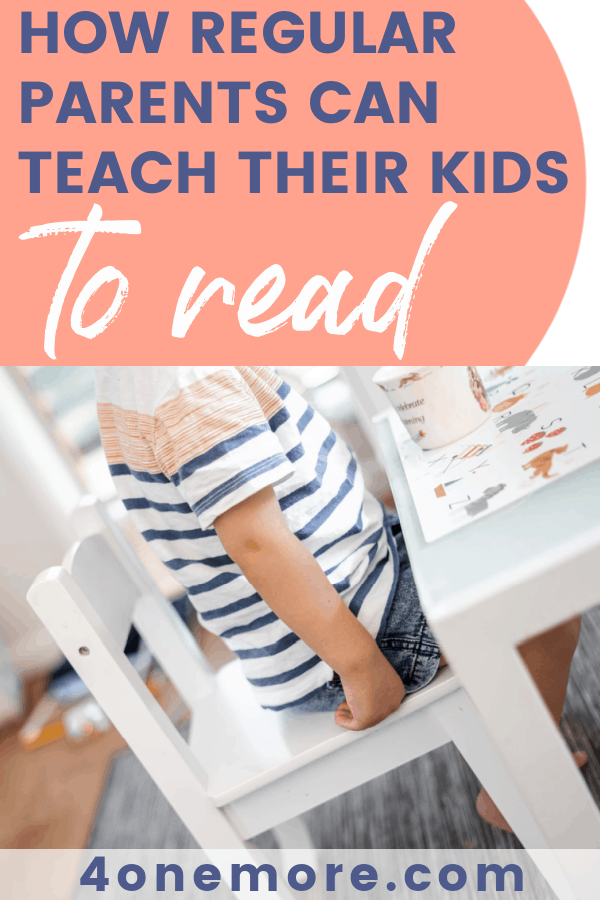Are you thinking about homeschooling your kids, but the whole teaching your kids to read feels above your pay grade? Do you think it’s best left up to the professionals? Think again. Even regular parents can teach their kids to read. Here’s how.

This post contains affiliate links for your convenience. I will receive a commission if you purchase from these links. Thank you.
Why We Think Only Professional Teachers Can Do It
Let’s do a little digging to see where we’ve been in recent American history with literacy rates.
Many people think of colonial Americans as uneducated or simple-minded. But the fact that Thomas Paine’s Common Sense sold so many copies that it could be compared to a best-seller today selling 15 million copies within 3 months tells a different story!
But what about Common Sense makes this point? Its literary style and complicated logic would allow only 13% of today’s adults in America to understand it. This is according to a survey by the National Assessment of Adult Literacy.
How did Americans learn to read in the colonial period? At home. Taught by parents. Without “professionals.”
Let’s move ahead a couple more generations. In 1840, the literacy rate in the United States was between 93-100%. This was before compulsory schooling.
During WWII, the approach to teaching children how to read in American public schools changed to non-phonetic methods. This had a devastating effect on the literacy rate in this country.
Today, only 48% of American adults can read and comprehend above a basic fifth-grade level! That is completely shocking when the teaching is largely being done by “professionals” and the average spending per pupil in the United States was just over $12K annually.
I’m guessing you were probably born sometime between 1960-1995. Those of us who have grown up during the last decades of the 20th century have been told so often that “professionals” are necessary to educate children.
In fact, they say this so often that we begin to believe it.
But is it true?
How Simple Is It Really?
Let’s talk about what it takes to teach a child to read.
Full disclosure: I’m approaching this topic as a homeschool mom, even though I have an education degree and am a former classroom teacher. I taught social studies at the middle school level, so I never received instruction during my college years on teaching phonics, because that was not my subject area of study. But I’ve been able to teach all five of my children how to read. And it wasn’t hard!
The crazy secret that schools don’t want you to know is that you CAN teach your child to read. It takes about 50-100 hours, depending on your child. That means in about 3 months, by consistently working little by little each day on phonics, your child will be able to read.
Teaching kids how to read is as simple as teaching these concepts:
- short vowel sounds
- consonant sounds
- short vowel words (cat)
- two consonant blends (ck, st, bl)
- consonant digraphs (sh, ch, th)
- long vowel, silent E words (lake)
- other vowel sounds (oo, oy, aw)
- “Bossy R” vowels (ar, ir, or)
- suffixes (ing, ed)
- simple two-syllable words
All it takes is sitting side by side on the couch or at the kitchen table and going through one concept each day for 15-20 minutes (or less!). Spend as many days as you need rehearsing and reviewing before you move on to new material.
One day you’ll be shocked because it will all just “click.” It really will! And it’s the best feeling ever to be a partner with your child in opening up the world to them through literacy. When you see the lightbulb go off, you’ll know it was all worth it.
Resources To Check Out
My go-to resource is The Ordinary Parent’s Guide to Teaching Reading. It’s all you really need, although magnetic letters help too!
Remember not to clutter “learning to read” with other language arts skills. Your kids do not have to also learn how to write all their letters at the same time. This is a different skill.
Don’t expect them to learn to fill out worksheets right away or have proper letter formation. These are different skills.
When you’re teaching your kids how to read, focus on that one skill. That’s one reason I like The Ordinary Parent’s Guide – it is scripted and focused on one thing. It doesn’t have all the bells and whistles of a fancy program that will just distract you and your child from simply learning phonics.
The lessons are scripted out, which will be a fabulous help for parents who lack confidence and just want to follow the plan.
However, the lessons are simple enough to look over before you start and then explain it to your child in a more natural way, if you’re okay with that kind of flexibility.
If you want some phonetic readers to help reinforce what you’re teaching, then the Bob Books are great.
If you are looking for a full curriculum that’s written with the homeschool parent in mind (that means, it’s not written for a classroom, but rather for one-on-one), then definitely check out All About Reading.
We’ve used All About Spelling, which is by the same company. All About Learning Press bases their curriculum on the Orton-Gillingham approach to phonics, which is recommended for dyslexics, but it also fabulous for all kids. Check out our All About Spelling review HERE to get a feel for that approach.
Final Encouragement
Remember – you can do it – even if you don’t have teaching credentials. Even if you’re not a professional.
“Don’t question your ability to teach your child. Question putting your child into the same system that left you feeling incapable of teaching your child.” Author unknown
You might like:
88 Things Every First Time Homeschool Mom Needs To Know